Linear Systems
advertisement
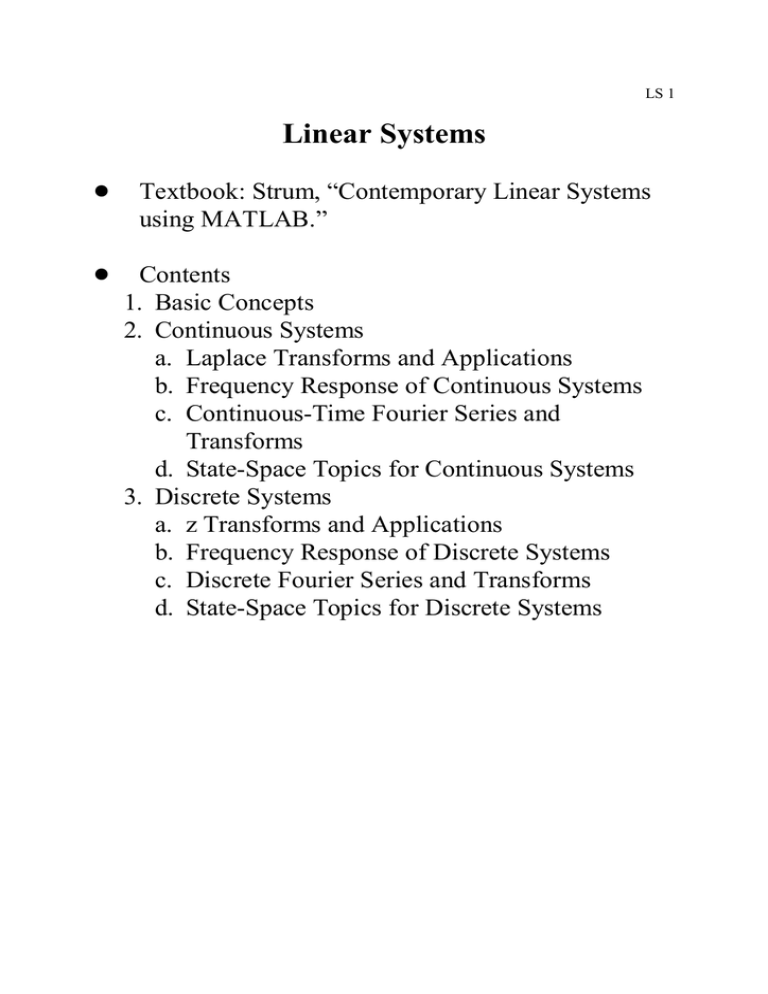
LS 1 Linear Systems ! ! Textbook: Strum, “Contemporary Linear Systems using MATLAB.” Contents 1. Basic Concepts 2. Continuous Systems a. Laplace Transforms and Applications b. Frequency Response of Continuous Systems c. Continuous-Time Fourier Series and Transforms d. State-Space Topics for Continuous Systems 3. Discrete Systems a. z Transforms and Applications b. Frequency Response of Discrete Systems c. Discrete Fourier Series and Transforms d. State-Space Topics for Discrete Systems LS 2 Chap. 1 Basic Concepts Continus V. S. Discrete Continuous System Discrete System LS 3 Unit Impulse 1. A virtual function. 2. Any arbitrary analog signal can be decomposed by impulses. 3. The response of any analog signal can be decomposed by impulse responses. Properties: (Sifting Property) Example: LS 4 Unit Step Function Representing Signals a. b. LS 5 Conversion between Continuous and Discrete Signals Sampling Theorem: Let : the maximum frequency component of the signal, : the sampling frequency. then if the signal can be uniquely represented by the samples, or the signal can fully recovered from the samples. LS 6 Chap. 2 Continuous Systems Basic Concept Linearity: A system is linear if and only if it satisfies the principle of homogeneity and additivity. 1. Homogeneity 2. Additivity 3. Homogeneity and additivity LS 7 Time Invariance: The same input applied at different times will produce the same output except shifted in time. That is, for arbitrary Linear Time-Invariant Systems (LTI): Linear + time-invariant. 1. Can be analyzed by Laplace and Fourier transforms. 2. In time domain, described by linear differential equations with constant coefficients. 3. In transform domains, described by linear algebraic equation. Causality: Output depends on only previous inputs. That is, depends on only . LS 8 Stability: if the input is bounded, the output is also bounded (bounded-input-bounded-output BIBO). Problems 2.1. Discuss the properties of the following continuous systems. a. . (i) Linear? (ii) Time invariant? b. . Causal or noncausal? c. Nth-Order Differential Equation Model In general, a single-input-single-output LTI system can be modeled by Nth-order differential equation as follows, Example: Initial Condition Solution of a Differential Equation 1. Find the homogeneous solution, i.e. LS 9 Let , substitute this to the above equation. Then, which is a polynomial called characteristic equation. Let be the roots of the characteristic equation, then Note: if stable, the real parts of the roots must be negative. The initial condition solution is in the form where are unknown coefficients to be determined by the initial conditions . Problem 2.2 Let a. Find the system’s characteristic equation. b. Find the root. c. Is the system stable? d. Find the general form of the homogeneous solution. e. Find the initial solution for and . The Unit Impulse Response Model Let the input be , and output , then response. For any input , we have is called impulse LS 10 Sifting property: Stability Definition: Problem 2.3 a. Find impulse response b. Is the system stable? . Convolution Let, Let , then , then LS 11 A continuous-time function can be broken up into a summation of shifted impulse functions. Suppose an LTI continous system has the response 1.Time Invariant 2.Homogeneity 3.Additivity of impulse LS 12 4.Let , then (Convolution Integral) where “*” is the convolution symbol. Alternative form: Example: LS 13 LS 14 Example: LS 15 Problem 2.4 , , find by MATLAB. Analytic solution: Problem 2.5 Convolution with Impulse functions. LS 16 Sinusoidal Steady-State Response What is the output when the input is an AC signal, that is, a sinusoidal signal? Since let, then, Let , then LS 17 Conclusion: in general, when a sinusoidal signal is applied to a stable LTI system, the output is . That is, the output is also a sinusoidal signal. Problem 2.6 A highpass filter has impulse response . If Find . First, compute The input 1. : . has two frequency components , no output. LS 18 2. : , the output is Alternative Path to Problem 2.7 A bandpass analog filter is described by where is the output and is input. a. Determine the frequency response. b. Find the output of LS 19 State-Space Model If there is no derivative term in the input, that is, we can define . Then we can turn the original equation to a set of first-order differential equations: We call state variables and the following state vector: . Then, the set of equations become in matrix form LS 20 A common definition for the state of a system is as follows: The state of a system is a minimum set of quantities which if known at are uniquely determined for by specifying the inputs to the system for . Why? The M ouputs single input where of a system are related to the states by the output equation is an M by N matrix and and a is an M by 1 vector. Problem 2.8 a. Describe the system in state variable form with and . b. Find the output equation if and . LS 21 System Simulation (Numerical Solution Using MATLAB) Consider Let , then Case 1: initial condition . . . . . . A=[0 1 ; -2 -3]; B=[0;1/3]; C=[1 0]; D=0; v0=[1;0]; tspan=[0 5]; x=@(t) 0; df=@(t,v) A*v+B*x(t); [t vv]=ode45(df,tspan,v0); plot(t,vv(:,1)); xlabel(‘t‘); ylabel(‘theta‘); Case 2: initial condition LS 22 v0=[0;0]; x=@(t) 1; df=@(t,v) A*v+B*x(t); [t vv]=ode45(df,tspan,v0); plot(t,vv(:,1)); xlabel(‘t‘); ylabel(‘theta‘); Example 2.1: An Oscillatory System a. Find the characteristic equation and roots. b. Solve for initial conditions of and . c. Write the state-space equation and use MATLAB to solve the equation. Assume . Plot the result with (b) to compare. LS 23 Example 2.2: Second-Order Systems where is the natural frequency. a. From , find b. Find the characteristic equation in terms of RLC circuit parameters and . c. Let L and C fixed and (i) Purely imaginary roots. (ii) Complex roots. (iii) Real roots. , find the range of R that will yield , or d. Find the state-space equation. e. Plot for the following cases: , , wn=10; zeta=2.3; K=100; A=[0 1 ; -wn^2 -2*zeta*wn]; B=[0;K]; v0=[0;0]; tspan=[0 2]; x=@(t) 1; , . , LS 24 df=@(t,v) A*v+B*x(t); [t vv]=ode45(df,tspan,v0); plot(t,vv(:,1)); xlabel(‘t‘); ylabel(‘theta‘); LS 25 Example 2.3 Unit Impulse Response of a Lowpass Filter A lowpass RC filter can be modeled by a. Find the characteristic equation. b. Find for c. Find for and . d. Find for and . e. Let and . , show that delta=1; A=-1; B=1; v0=0; tspan=[0 4]; x=@(t) (t<=delta && t>=0)/delta; df=@(t,v) A*v+B*x(t); [t vv]=ode45(df,tspan,v0); plot(t,vv); xlabel(‘t‘); ylabel(‘theta‘); LS 26 Example 2.4 Convolution a. An LTI causal system is modeled by unit impulse response Prove that for , b. A finite duration integrator can be modeled by the unit impulse response . If the input is . LS 27 , Find the output by graphic method. c. Find the output by analytical method. d. If the hypothetical integrator is modeld by the noncausal unit impulse response , find .
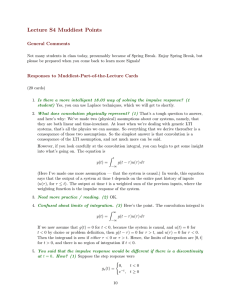
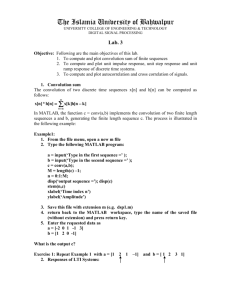
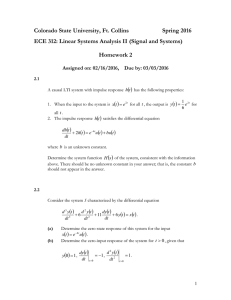
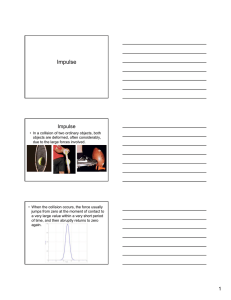

![2E2 Tutorial sheet 7 Solution [Wednesday December 6th, 2000] 1. Find the](http://s2.studylib.net/store/data/010571898_1-99507f56677e58ec88d5d0d1cbccccbc-300x300.png)